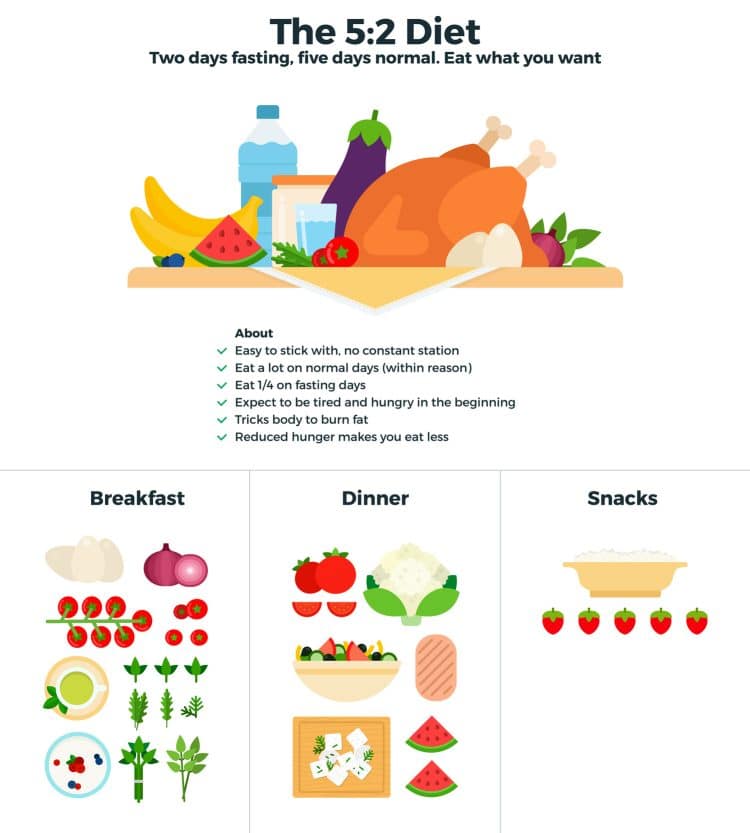The widespread prevalence of obesity motivates me to address this crucial subject frequently.
Many diets promise big results, but they are nothing more than fads. That said, what works for one individual may not yield the same results for everyone, owing to our unique physiological differences.
My experience as a nutritionist and personal trainer has shown me one-size-fits-all options simply don’t exist. This is even backed by a review published in the Journal of Obesity & Metabolic Syndrome, highlighting there is no one best strategy for weight management. (1)
However, one particular diet strategy stands out — intermittent fasting (IF). It can help you lose weight and promote a healthy lifestyle.
There are several intermittent fasting methods, so in this guide, I will explain the seven best plans and the science behind IF. I’ll also leave you with some useful tips you can apply immediately.
Science Behind Intermittent Fasting
Level Up Your Fitness: Join our 💪 strong community in Fitness Volt Newsletter. Get daily inspiration, expert-backed workouts, nutrition tips, the latest in strength sports, and the support you need to reach your goals. Subscribe for free!
A lack of scientific evidence (and results) makes me skeptical about numerous popular diets.
But intermittent fasting is different. It works by causing positive metabolic shifts, improving insulin sensitivity, and triggering cellular processes like autophagy.
Autophagy is backed by science and involves degrading and recycling damaged or dysfunctional cells. In 2016, Yoshinori Ohsumi won the Nobel Prize in Physiology or Medicine for “discoveries of the mechanisms for autophagy.” (2)
During fasting, when you are not eating, your body begins the process of autophagy, clearing out cellular waste and helping cells fix themselves.
When you alternate between fasting and eating, your body becomes better at managing energy and stabilizing blood sugar levels. (3)
7 Nutritionist Approved Intermittent Fasting Plans for Beginners
Below, I list fasting plans ranging from the least demanding to the most challenging.
Begin your intermittent fasting journey by trying out easier plans first, then gradually work your way up to more extreme versions. Trying easier fasting plans will help you determine whether intermittent fasting is your cup of tea or not.
12:12 Intermittent Fasting
This approach involves fasting for 12 hours and eating within a 12-hour window. It’s one of the simplest methods and can be easily incorporated into daily life.
I follow 12:12 IF several times during the month and can attest to its long-term sustainability. Whether my clients want to lose weight or improve their eating habits, I advise them to begin with the 12:12 method.
In this method, I recommend having your last meal of the day before 9 p.m. and breaking your fast the next morning after 9 a.m. Practically, the only thing you eliminate in this diet are late-night snacks — they are usually unhealthy and redundant anyway.
The 12:12 fasting schedule perfectly aligns with natural circadian rhythms. So, if you are not working night shifts, the period without food is mostly during sleep. Even if you work a job that prevents you from having a strict schedule, the 12:12 intermittent fasting method is flexible and adaptable. If you need to eat at midnight to avoid hunger during the night, just push or skip your breakfast.
Eating within a 14-hour window aligns with intermittent fasting as well. However, the benefits of 12:12 are much more significant, and I’m sure you can endure those two additional hours without food.
14:10 Intermittent Fasting
The 14:10 method is one step above the 12:12 method.
This plan extends the fasting window to 14 hours, followed by a 10-hour eating window. That slightly longer fasting period will have an even better effect on your metabolism, and fighting off hunger will not be difficult.
A slight adjustment will not force you to change your eating schedule significantly. For example, you can start fasting at 8:00 p.m. and break your fast at 10:00 a.m. the following day. So, you still have plenty of time for breakfast, lunch, dinner, and snacks.
Again, you can move the eating window to suit your work, exercise, and other commitments.
16:8 Intermittent Fasting
The 16:8 intermittent fasting method is the most popular among IF enthusiasts.
Many of my clients think that 16:8 is the only IF plan because it is the most talked about. However, that is not the case. There are several IF methods, and you should pick the one that best fits your lifestyle.
Once you try 16:8, you will realize it is easier than it sounds. You need to skip breakfast and delay the day’s first meal until later in the morning or early afternoon. After that, you can have several smaller meals or two large meals. If you decide to have two large meals, that’s completely fine, and you can still get all the necessary macronutrients and micronutrients. But you have to plan those two meals well because you won’t have time to make up in later meals.
You can also skip dinner and eat only breakfast and lunch if you prefer breakfast over dinner. To be honest, it’s not my favorite way because I can’t sleep if I’m hungry. In any case, it’s up to you to decide.
5:2 Intermittent Fasting
Now, we come to fasting plans that require strong planning and willpower.
In this IF method, you eat normally five days a week — no fasting, special meal plans, or anything. On the remaining two (non-consecutive) days of the week, your calorie intake should be in the range of 500 to 800 calories, which is a significant restriction.
It’s essential to restrict calories on two non-consecutive days. If you try the 5:2 method on back-to-back days, you will exhaust yourself, and it is not an effective way to achieve any fitness goal.
On non-fasting days, continue to eat a balanced diet; otherwise, you will probably gain weight. Remember, non-fasting days are not cheat days.
The 5:2 intermittent fasting method is easier to plan than daily fasting protocols, but energy levels can be poor during fasting days. So, it’s best to avoid workouts on this IF plan.
I’m not a huge fan of this type of intermittent fasting because it is not sustainable. If you still decide to try the 5:2 IF protocol, try to avoid food for at least 12 hours during the two fasting days.
Eat Stop Eat Intermittent Fasting
The Eat Stop Eat method involves fasting 24 hours once or twice a week. It resembles religious fasting.
Level Up Your Fitness: Join our 💪 strong community in Fitness Volt Newsletter. Get daily inspiration, expert-backed workouts, nutrition tips, the latest in strength sports, and the support you need to reach your goals. Subscribe for free!
Fasting for a full 24 hours triggers significant metabolic changes in the body. It will undoubtedly increase fat burning, improve insulin sensitivity, and promote cellular repair.
Doing it twice a week is too much, in my opinion, and is only useful for obese people who need to lose a lot of weight in a short period. Even in that case, it can be too challenging and cause extreme hunger, fatigue, poor focus, etc.
I recommend initially trying this IF method on your day off. Without food, you will not have enough energy to go to work and perform everyday duties. If you are persistent, your body will eventually get used to this eating pattern, and you will be able to get through the day pretty normally. But in the beginning, it will be taxing.
The day before the fast, opt for nutrient-dense foods rich in vitamins, minerals, and antioxidants instead of high-calorie junk food.
Alternate-Day Intermittent Fasting
Alternate-day fasting is similar to the 5:2 intermittent fasting, but instead of fasting only two days a week, you will fast every other day.
Alternating between fasting and regular eating days is a good approach for further reducing weekly calorie intake. Reduce calorie intake to around 500 on fasting days or abstain from food altogether. However, I don’t recommend the latter to my clients. Simply put, we aren’t designed to go without eating for three to four days a week.
Consume meals as usual on eating days. I have found that this can be very tricky. Several of my clients tend to overeat on regular days. After exposing your stomach to a large amount of food after a 24-hour hiatus, the risk of bloating, diarrhea, and nausea rises. You have to be mindful on eating days and eat as usual or maybe increase calorie intake a bit, around 200 to 400 kcal, not more.
One Meal a Day (OMAD)/The Warrior Diet Intermittent Fasting
Why did I put these two diet plans together? Because the difference is almost nonexistent.
With the OMAD approach, you eat all your daily calories within a one-hour meal window. The warrior diet allows you to eat tiny amounts of raw fruits and vegetables before a single, major meal.
Those two methods may have certain benefits, such as convenience and simplicity, but I consider these unhealthy.
Let’s say you need to consume 2,000 calories per day. You’ll face the dilemma of consuming 2,000 calories in one sitting, which can lead to discomfort or depriving your body of essential macros and calories. Besides, no reputable study has confirmed any long-term benefits of such an approach.
You can try the OMAD/Warrior diet if you are healthy and like to experiment with different diets, but stay away from them if you have any pre-existing medical concerns.
Important Considerations for Intermittent Fasting
Knowing the types of intermittent fasting plans is not enough. There are other crucial factors you must consider before starting a diet routine.
Hydration
I cannot stress how important hydration is during intermittent fasting. My clients know how often I remind them to drink plenty of fluids, even when they don’t follow intermittent fasting.
I have a tip for you: Make it a habit to always bring a water bottle with you wherever you go. Whether at work, running errands, or relaxing at home, keep a water bottle within reach.
During fasting, you can infuse your water with slices of lemon, cucumber, or fresh herbs like mint or basil. Chamomile, peppermint, or ginger tea are my go-to options as well. Be creative; the only thing that matters is that the calorie content remains zero. Strive for at least 85 ounces of water daily, adjusted to activity level and weight.
Nutrient Density of Foods
What you eat daily has a colossal impact on your overall health.
Intermittent fasting requires you to care even more about your diet than usual. Thorough planning is necessary to ensure your body receives the essential nutrients it needs.
When you’re starving after a fast, I know reaching out for pizza and doughnuts is very tempting. However, it is not the right choice. Choose nutrient-rich foods that not only satisfy your hunger but also nourish you from the inside out. Focus on lean meat, vegetables, and healthy carbs and fat sources.
When it’s time for a cheat meal, eat something delicious and nutritious. For example, a burger is a better option than fries with cheese and soda.
Exercise and Physical Activity
Pairing intermittent fasting with regular physical activity is the perfect strategy to feel healthy and energetic.
Discover activities you’re passionate about, as this will transform exercise from a burden into something you eagerly anticipate. After a long day, I can’t wait to play tennis or do weight training at the gym. You should choose the activity based on your interest — gym, basketball, tennis, rucking, yoga, or something else. It’s best to combine several different activities.
During intermittent fasting, plan your workouts for periods when you feel sufficiently fueled amidst
FAQs
Can I drink coffee or tea during fasting periods?
Absolutely, you can enjoy black coffee or tea during fasting periods, but it must be unsweetened and without cream. There are conflicting opinions on whether only sugar affects insulin levels or sweeteners, too. That’s why I always encourage my clients to opt for unsweetened drinks, regardless of whether they prefer sugar or alternatives.
Coffee and tea can suppress appetite, which is excellent when you are not allowed to eat.
Is it possible to build muscle while intermittent fasting?
My clients are often reluctant to start a new diet plan out of fear of losing muscle.
You must rest assured it is possible to build muscle during intermittent fasting. Actually, it is one of the best ways to lose fat and gain muscle simultaneously. You just have to follow a structured workout routine and monitor your macronutrient intake during eating windows.
Can intermittent fasting be combined with specific dietary approaches like keto or veganism?
Yes, intermittent fasting can be combined with various dietary approaches, including keto and veganism. Together with a ketogenic diet, it will undoubtedly enhance fat loss. That being said, it is very challenging, and I would only recommend IF plus keto to those who have tried both approaches before. Pairing with a vegan/vegetarian diet is straightforward—follow the same eating windows and patterns.
Is intermittent fasting advisable during pregnancy or breastfeeding?
No, intermittent fasting is not recommended during pregnancy or breastfeeding. During that period, you have increased nutritional demands, and thus, you must prioritize regular, balanced meals. Never experiment with anything unconventional. Follow personalized plans from your doctor or nutritionist.
Wrapping Up
Intermittent fasting can be a powerful tool for weight loss and overall well-being if utilized correctly.
The most important thing is to choose a fasting schedule that aligns with your goals and lifestyle. If you immediately try one of the more extreme options, chances are you will give up before you even experience the benefits. Also, once you start, listen to your body to prevent potential risks.
As always, talk to your doctor before significantly changing your diet. We certainly don’t want to cause more harm than good by following intermittent fasting if there is an underlying medical issue.
If you have any questions, I will be happy to answer them in the comment section below.
References
- Kim JY. Optimal Diet Strategies for Weight Loss and Weight Loss Maintenance. J Obes Metab Syndr. 2021 Mar 30;30(1):20-31. doi: 10.7570/jomes20065. PMID: 33107442; PMCID: PMC8017325.
- Rubinsztein DC, Frake RA. Yoshinori Ohsumi’s Nobel Prize for mechanisms of autophagy: from basic yeast biology to therapeutic potential. J R Coll Physicians Edinb. 2016 Dec;46(4):228-233. doi: 10.4997/jrcpe.2016.403. PMID: 28504774.
- Yuan X, Wang J, Yang S, Gao M, Cao L, Li X, Hong D, Tian S, Sun C. Effect of Intermittent Fasting Diet on Glucose and Lipid Metabolism and Insulin Resistance in Patients with Impaired Glucose and Lipid Metabolism: A Systematic Review and Meta-Analysis. Int J Endocrinol. 2022 Mar 24;2022:6999907. doi: 10.1155/2022/6999907. PMID: 35371260; PMCID: PMC8970877.












